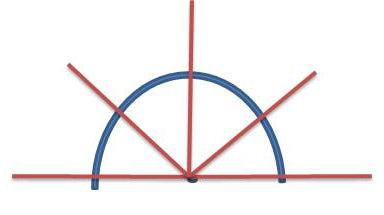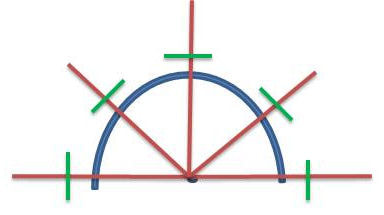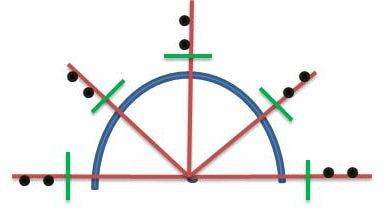Bringing Right Hip Forward in CornerBy Susan Ellis, May 2011
|
When you do the common things in life in an uncommon way, you will command the attention of the world. ~ George Washington Carver |
To be able to carve your skates around the corner and continue to push at the same time, your blade needs to follow the radius of the curve, right from set down of blade and all the way through the push. To do this your hips and shoulders need to stay perpendicular to the tangent line of the turn. Keeping your hips perpendicular to the tangent line keeps your skate moving with the radius of the turn, which allows your blades to stay on the ice longer during the push. If your blade moves away from the tangent line (radius), your hips open up, and your push is shortened. By the same token, if you allow your right hip to fall too far back of your left hip, or bring it too far forward, your push will be shorter. Your right hip is farther away from the turn so it has to travel farther and faster than your left hip to be able to keep your hips perpendicular.
Bringing the right hip forward takes time and patience to consciously press in to the ice as you are pushing. Watch this video and follow his hips through both the right and the left leg push. You will see that his hips are always following the tangent line of the curve. Now watch again and follow his skate as it carves along the tangent line during the entire push.
This video is a good comparison – the lead skater is bringing his right hip forward with him during each push while the second place skater is simply pushing without bringing the hip. Here the two pushes are broken down into Right leg push and Left leg push. Notice on the right leg push the skater in the lead takes more time to press in to his push and his right hip comes slightly farther ahead than the skater behind, so there is more pressure time in to the ice. The second skater’s right push lifts off the ice slightly before the lead skater. Watch the lead skater’s left leg push now and you can really see the difference in length of push, and therefore pressure time in to the ice. You can really see how far forward his right hip comes, and because he is maintaining pressure through the push, his left blade carves a much longer distance than the skater in second.
This video is a good comparison – the lead skater is bringing his right hip forward with him during each push while the second place skater is simply pushing without bringing the hip. Here the two pushes are broken down into Right leg push and Left leg push. Notice on the right leg push the skater in the lead takes more time to press in to his push and his right hip comes slightly farther ahead than the skater behind, so there is more pressure time in to the ice. The second skater’s right push lifts off the ice slightly before the lead skater. Watch the lead skater’s left leg push now and you can really see the difference in length of push, and therefore pressure time in to the ice. You can really see how far forward his right hip comes, and because he is maintaining pressure through the push, his left blade carves a much longer distance than the skater in second.

Maintaining pressure and carving through the push is a matter of:
1) correct body position – hips do not rise up
2) pushing down in to the ice
3) right hip moving forward
4) high knee lift
In this video you will see that the skater's position does not change through the push and cross. Look at how she really squeezes her right thigh up high and diagonally across her chest during the cross. By bringing her knee high and forward at the same time it helps to get that last little bit of hip coming forward and squeezes a couple more inches out of her push.
You can see in this video that when she lands her right she really presses hard down in to it with her hip and brings her hip forward as she brings her left through. Note that when her left comes through, her thigh again comes very close to her chest.
In this video watch the carve the skater in the white shirt gets throughout his push as he:
Here are a couple more good examples:
Video – skater in last place
Video
Video – #19
1) correct body position – hips do not rise up
2) pushing down in to the ice
3) right hip moving forward
4) high knee lift
In this video you will see that the skater's position does not change through the push and cross. Look at how she really squeezes her right thigh up high and diagonally across her chest during the cross. By bringing her knee high and forward at the same time it helps to get that last little bit of hip coming forward and squeezes a couple more inches out of her push.
You can see in this video that when she lands her right she really presses hard down in to it with her hip and brings her hip forward as she brings her left through. Note that when her left comes through, her thigh again comes very close to her chest.
In this video watch the carve the skater in the white shirt gets throughout his push as he:
- holds his position
- presses in to the ice hard with his left
- lifts his right knee high and moves diagonally across his chest
- while bringing the right hip forward.
Here are a couple more good examples:
Video – skater in last place
Video
Video – #19




